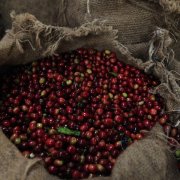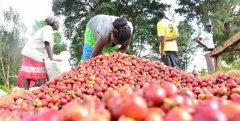Flavor characteristics of Kenyan boutique coffee beans introduction to Kenya AA TOP Coffee Grade

For professional baristas, please follow the coffee workshop (Wechat official account cafe_style)
Product name: Kenya AA TOP Katooji
(Kenya Katugi AA TOP)
Flavor description: blackcurrant, blackcurrant, spices, black plum, red grape tail, maple syrup sweet
Production area: Nyeri, Catuji town (Katugi)
Producer: Catuji Water treatment Plant (Katugi)
Varieties: SL28, SL34
Classification: AA TOP Kenyan washing
Altitude: average 1860 m
Treatment: Kenyan washing treatment
Harvest time: NumberA
Introduction:
Catuji Water treatment Plant (Katugi), built in 1979, is an Othaya farmers' cooperative.
One of its members, located in the south of Nyeri, on the eastern slope of Aberdare.
It is about 140km north of Nairobi, the capital of Kenya, with an average altitude.
1860 meters, Osaya Farmers' Cooperative (the Othaya FCS cooperative)
Founded in 1956, it had only 256members, and today it has 14000 members.
There are 19 water treatment plants, which is the largest cooperative in Kenya. Catuji Water treatment Plant (Katugi)
It is one of the 19 processing plants of the Osaya Farmers' Cooperative (the Othaya FCS cooperative).
The service staff of Catuji Water treatment Plant (Katugi) is about 750. it is dedicated to Katuji.
Set up by small coffee farmers near the town (Katugi) to deal with raw beans, the planting area of small coffee farmers is about
233 acres. Here the mountains are well drained and are nourished by volcanic red soil rich in organic matter.
Coffee bushes, enough altitude and cool climate to make the coffee fruit slowly
The development and maturity has created coffee raw beans with extremely high hardness. The main production season is from October to December.
An average of 250-300 coffee trees are planted in each farm, and farmers are under the supervision of regional committees.
Strictly abide by the planting policy; at the same time, in order to enhance biodiversity and maintain crops
Good growth and intercropping-in addition to coffee, grevillea and macadamia are also grown.
As shade trees, and banana trees and other fruit trees as shade.
The history of coffee cultivation in Kenya dates back to the end of the 19th world, and coffee trees were planted by neighboring countries in the north.
Introduced into Ethiopia and improved by its own varieties, the common varieties are bourbon species.
(Bourbon), Ken Special (Kents,SL34, SL28), Tibica (Typica) and
Four varieties of Luli 11 (Riuri 11). Most Kenyan coffee is uncertified.
Organic cultivation, due to the use of improved planting techniques, rarely uses chemical pesticides or herbicides.
Kenyan premium coffee (AA Plus, AA, AB, PB) are all washed and sun-dried beans.
The low-grade products of non-washing treatment (non-washing 39% buni) are for local use only.
Important Notice :
前街咖啡 FrontStreet Coffee has moved to new addredd:
FrontStreet Coffee Address: 315,Donghua East Road,GuangZhou
Tel:020 38364473
- Prev

Description of coffee flavor and aroma in Ethiopia sun Xidamo G1 Valley Giannasola Farm
Professional barista exchanges please follow the coffee workshop (Wechat official account cafe_style) Ethiopian Sun Sidamo G1 Valley Giannasola Farm single Farm Lot3 (Ethiopia Sidamo Guji Ana Sora Lot3 Natural G1) flavor description: strawberry biscuits, integrated berries, citrus, flowers, maple syrup aroma, sweet and bright acidity, mouth
- Next

Description of Flavor and Taste of Fine Coffee in Kenya AA TOP Mahiga processing Plant
Professional baristas exchange please follow the coffee workshop (Wechat official account cafe_style) Product name: Kenya AA TOP Mahiga (Kenya Mahiga AA TOP) flavor description: plum, tea, kumquat, fine flowers. Country of origin: Kenya (Kenya) producing area: Neri producing area (Nyeri) producer: Mahiga treatment plant (Mahiga Factory) variety
Related
- Detailed explanation of Jadeite planting Land in Panamanian Jadeite Manor introduction to the grading system of Jadeite competitive bidding, Red bid, Green bid and Rose Summer
- Story of Coffee planting in Brenka region of Costa Rica Stonehenge Manor anaerobic heavy honey treatment of flavor mouth
- What's on the barrel of Blue Mountain Coffee beans?
- Can American coffee also pull flowers? How to use hot American style to pull out a good-looking pattern?
- Can you make a cold extract with coffee beans? What is the right proportion for cold-extracted coffee formula?
- Indonesian PWN Gold Mandrine Coffee Origin Features Flavor How to Chong? Mandolin coffee is American.
- A brief introduction to the flavor characteristics of Brazilian yellow bourbon coffee beans
- What is the effect of different water quality on the flavor of cold-extracted coffee? What kind of water is best for brewing coffee?
- Why do you think of Rose Summer whenever you mention Panamanian coffee?
- Introduction to the characteristics of authentic blue mountain coffee bean producing areas? What is the CIB Coffee Authority in Jamaica?

